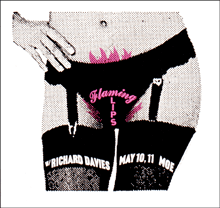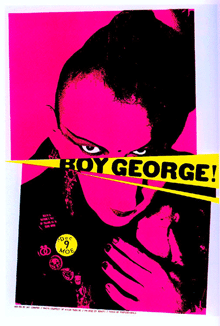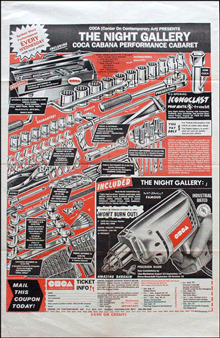
Art Chantry
November 18, 2002
by Christopher May
Speak Up: As a designer that
has started his career before the mainstream use of computers, do you see the
computer as a tool, crutch, or hindrance?
Art Chantry: I view computers
with huge ambivalence. It is both a blessing (in that it extends the dialog
of graphic design back into the hands of the amateur - the primary source of
innovation) and away from the hands of the knowledgeable professional (often
the source of control and self-interest). I love the Internet and the computer
communication world. I don't love the computer as a one-stop all-solution design
tool. It’s a remarkably flawed production tool as well. The history of
the language of design is one of collaboration and interactivity. The computer
takes away most of that group process and puts it into the hands of one single
person. I used to rely upon a score of craftsmen and artists to complete my
tasks - typesetters, copywriters, illustrators, proofreaders, editors, photographers,
darkroom strippers, pre-production, press operators, paper experts, salesmen,
etc. etc. One by one all of this expertise has been eliminated (500+ years of
skill) and suddenly dropped into MY lap. Subsequently, quality has to go down.
On top of that, since I’m suddenly competing with people (and clients)
who literally bought software a week ago and are now perfectly competent in
graphic design to a very high level. What I can ask for my 'art' is devalued
dramatically. Be honest, who really needs to hire me when they can spend much
less money and do it themselves? Currently, I am getting rates below what I
was charging when I started out almost 30 years ago. In addition, I now have
to support $20,000 worth of equipment and upgrades. All for the clients in the
design market to get a uniform c-level quality of execution.
As you can see, computers are a truly mixed bag. It’s thrown the 'industry'
into a buyer's market. The client has never had more total control over graphic
design. How often does the client take your disk and personally re-work it?
That NEVER happened before the computer. Graphic design was respected as a sort
of magic that helped people (usually to make money). Now it's a troublesome
decoration process that must be applied to stay even. Sad.
We are almost at a point where we need to redefine the term 'graphic
designer' in order to differentiate between what is going on in the industry
of design versus the language of design. What I do can just barely be considered
'graphic design' anymore. But I haven't changed, the industry has changed. Strange.

|
 |
|
Graphic design was respected as a sort of magic that helped people (usually to make money). Now it's a troublesome decoration process that must be applied to stay even. Sad.
|
|

SU: Working with such raw and
tangible materials, do you feel this gives you more opportunity to experiment
than if you worked digitally?
AC: Yes. The versatility of the
eye combined with the hand has carried human creative endeavor through a quarter-million
years of history. There is no more direct path to ideas than hardwired mind-to-fingers.
The more variety of raw materials you place into that creative mosh, the more
solutions and ideas are presented. Computers are just one very small aspect
of that material available for use.
SU: How often do you incorporate
happy accidents into your design?
AC: Constantly. That is where
ideas come from. New ways, unexpected ways, surprising ways things interact
are a constant source of wonder for all of us. We can't control everything we
touch, so we need to take delight in what is possible, even by accident.
SU: When your work goes into
production, what methods do printers use to reproduce your work (i.e.; do they
scan, photograph, photocopy, silk screen etc.)?
AC: I still prefer darkroom film-stripping
(as do most printers. Contrary to popular belief, printers absolutely hate what
computers have done to the art of printing). When 'middlemen' attempt to digitize
my work, it seldom seems to work out, because the mindset and knowledge base
of that middleman (AKA digital prepress) is so very different from mine. My
work is designed to go on a printing press, not a computer screen. These are
titanically different things. A digital prepress person needs to be able to
convert the way they think into the way I think and how that pertains to printing.
Usually the opposite happens, and they attempt to 'adapt' or 'correct' my work
to fit their perception of 'digital' printing process (which is so different
from 'physical' printing process). But the paradigm has dramatically shifted
in just a few short years. You would be amazed how often they totally redesign
my work and destroy it. I would much rather rely on a printer. A good relationship
with a service-oriented printer with a respect for quality is worth a thousand
clients. I protect my craftsmen. I want them to protect me. We need each other.
They make me look brilliant, I do the same for
them. Everybody wins.
My 'art', such as it is, involves the simple task of laying a layer of ink down
on a piece of paper one at a time. Just how I lay that ink down is where the
magic happens.

|
Once or twice, clients have turned out to be utterly reprehensible people who become too rude and unbearable to suffer any longer and I’ve been forced to abruptly end the relationship. I instinctively treat people as they treat me. I give respect to those who give me respect. What could be more fair? |
|
 |
|

SU: Does the integrity of your
work supersede monetary gain? In other words have you ever found yourself giving
into client demands, which could weaken a concept, or do you tell them where
to go?
AC: 1) Usually, but that decision
happens in the beginning, primarily based on my interest in the human aspects
of the project (the thought, the personality, the passion, etc.) Once you take
on the project, you're committed to helping that client to achieve their goal.
You need to asses that goal at the beginning or you have no more choice in the
matter. This is supposed to be a 'service' industry. Who do you 'serve'?
2) The PROCESS and DIALOGUE of graphic design is a collaboration with a client.
When it works well, there is nothing sweeter - some of my clients have become
lifelong close friends. On the other hand, there have been cases where the collaboration
is not working and I have suggested ending the process because the work that
comes out of it will not be up to even mediocre standards. Once or twice, clients
have turned out to be utterly reprehensible people who become too rude and unbearable
to suffer any longer and I’ve been forced to abruptly end the relationship.
I instinctively treat people as they treat me. I give respect to those who give
me respect. What could be more fair?
SU: Being at a status where
companies such as Nike, Microsoft, and Coca-Cola have pursued your creative
talent, what is your take on working with corporate clientele?
AC: I really have no problem
with corporate clients - if they treat me well and pay fairly. However, my experience
with corporate clients is that of dealing with a bureaucracy where no one person
ever seems to be authorized with making a decision. They may say they do, but
they always have to 'run it by' someone who invariably damages the process anonymously.
It makes the middleman (your contact) an automatic liar. The fear of decision-making
in the corporate 'culture' is what leads to 'legal' being the final say-so in
every silly aspect of the process. It’s counterproductive to quality. Corporate
clients also will do everything in their power to not pay their bills. They
have entire staffs of accountants, bookkeepers and LAWYERS who do nothing other
than try to minimize money going out. I, on the other hand, don't. Every single
time, without fail, I end up losing money on corporate projects.
On the other hand, going direct with small businesses has resulted in a level
of integrity that truly inspired me. The bottom line is that if a
small business doesn't work on an honest playing field, they lose their credit
and the their 'good name' and they go out of business because nobody will work
(AKA 'collaborate') with them. The result is a much more satisfying process
all around.
SU: A lot of your work seems
to have a dark counter-culture, and sometimes warped sense of wit. How deep
do you expect the observer to read into your work?
AC: My work with subcultural
groups stems from several aspects of my interest in anthropology (I originally
wanted to be an archaeologist). I’m fascinated by the visual language forms
developed by subculture groups to speak privately among themselves - it's a
way of self definition. These visual language forms are invariably eventually
absorbed into mainstream culture, sometimes with the ideas intact, sometimes
altered. This is a primary source of fascination in the language I love. I constantly
discover whole new worlds to explore and keep learning. I’m never bored
with what I do.
Since these subcultural languages are originally a private language (example
- psychedelic posters were difficult to read and shockingly strange to behold
in order to scare away the mainstream and attract like-minded people to those
music events), it only follows that, as the subcultural language is absorbed
into mainstream, that those ideas presented will at first be foreign to the
mainstream. In time, those ideas become cultural clichés that everyone
understands, thus destroying that secretiveness. You will see this in my work
as it ages over a period of time (the 'darkness' and 'warped wit' will dissipate).
It’s part of my learning process to constantly absorb these different visual
language 'accents' and 'slangs' into my vocabulary. It’s how culture progresses.
It’s total involvement in graphic design as a cultural language.

|
 |
|
I figured that in ten to twenty years there would be only, say, 10% of what I was trained to think of as 'graphic designers' left still practicing. These would be the idea people that everybody else would 'emulate'. This is where I wanted to be positioned. The rest of the pack would be 'graphic technicians' or 'graphic decorators' whose job it would be to make things look nice for businessmen. I was right. It worked.
|
|

SU: What was your most memorable
project / client? Why?
AC: Dave Crider at Estrus Records.
It’s been a dozen years and we've become very best friends. The work we've
done together for his record company was the result of a terrific collaboration
process of similar minds (he even wanted to be an archaeologist at one point,
a synchronicity that is obvious in our collaborations) that has benefited both
of us and has influenced a generation of musicians, designers and scenesters.
It has been an influential piece of design history that was created by this
collaboration. It doesn't get better than that.
SU: How much of your life experiences
find it’s way into your work?
AC: I truly believe that in the
very best design the hand and mind of the designer is utterly invisible. By
this very standard, the extreme stylism of my work is a contradiction to 'quality'
design. However, I chose this path very consciously back in the early 1980's,
when I first saw what computers were capable of. I quickly realized that if
I continued on a true design path, I would be put out of work by a computer
program. I figured that in ten to twenty years there would be only, say, 10%
of what I was trained to think of as 'graphic designers' left still practicing.
These would be the idea people that everybody else would 'emulate'. This is
where I wanted to be positioned. The rest of the pack would be 'graphic technicians'
or 'graphic decorators' whose job it would be to make things look nice for businessmen.
I was right. It worked.
SU: It has been said that Art
Chantry has a reputation of being cranky - a complete a**hole. How much of it
is true?
AC: I think of myself as a person of frank and
open ideas and opinions delivered in a straightforward manner. In America
in 2002, this is considered 'cranky' and an 'a**hole.' I never get considered
a good 'team player' because I want the 'coach' to listen to me and consider
my input. A 'team' is not a good 'process' - it's a good ARMY. A friend of
mine pointed out that there is no 'I' in 'team', but there is a 'me'.
I think I’m honest and funny (in a dark way). Privately people think
I’m a very nice and generous person. People who treat me badly, however,
get treated badly in return. I think this is fair.
SU: You made a great remark
in a recent post on gigposters.com; "Lester Beall is one of my design heroes...
if he could do that shit back in 1938, I could do it in 1980." Are there
any other designer / artists / people that have inspired you as much?
AC: That’s a huge question.
The creative work by people I admire, the careers and contributions would fill
to many hours and hours of work and space to list here. I’m currently working
on a book with a working title (it will change): 'A Secret History of Graphic
Design". It attempts to compile the contributions of all of these people
and subcultures into a seamless and unrecognized (at least by academia) history
of visual culture. Look for it in a couple of years. It’s a lotta work,
dude!
SU: Thanks Art for your insight.

This interview has been conducted exclusively for Speak Up.
Reproduction without our written consent is strictly prohibited. Please if you would like to use it for educational purposes or if you are interested in other means of reproduction. Thank you for your understanding.




